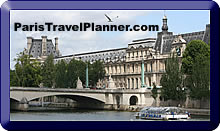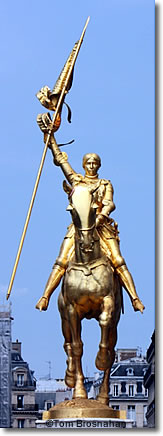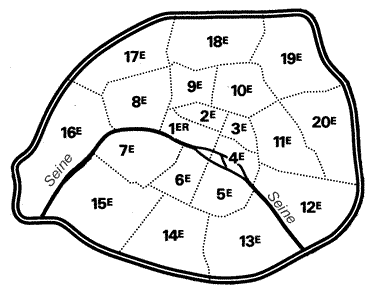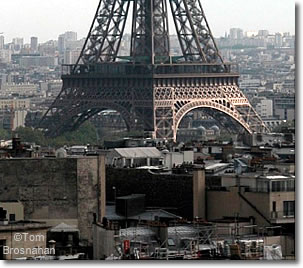 |
Arrondissements in Paris, France | |
| True Parisians, whether resident or visitor, know Paris's arrondissement system, a charming anachronism. Jane does. Tom ignores them. He uses landmarks and Métro stations to find his way around Paris. | ||
|
|
||
|
|
|
Medieval Paris was at the very heart of what is now the modern city, but since medieval times Paris has grown and absorbed many surrounding communities. These once-outlying medieval villages live on as the arrondissements or municipal "boroughs" of Paris. As in the boroughs of New York City or London, each arrondissement has its own mini-city government and its own character. Paris's arrondissements are numbered from 1 to 20, starting from the premier (1er) in the old medieval town center (the Louvre) and progressing in a clockwise spiral to the final 20th arrondissement which includes the famous Père Lachaise cemetery on the eastern side of the city:
In the old days, Paris addresses bore the number of the arrondissement (1er for premier, 2e for deuxième, 3e for troisième, etc.) as in Paris 4e, but today you'll see a modern postal code such as 75004, meaning that the address is in Paris (75), in the 4th arrondissement (004), which includes Île St-Louis and part of Le Marais. Each arrondissement has a character and a meaning for Parisians: Paris 1erThe 1st (1er) is the historic center at the heart of Paris: the Louvre, the Tuileries gardens, Comédie Française, the Banque de France—museums, theater, shopping, commerce. Paris 2eJust north of the 1er, here you'll find the Bourse and the delightful 19th-century shopping galeries and passages, like the Galerie Vivienne. Paris 3eThe 3rd (3e), east of the 1st and 2nd, is the quieter northern part of Le Marais, now a residential district of young professionals. Paris 4eThe 4th, southeast of the 1er and south of the 3e, includes most of Le Marais, once a swamp, then the ancient Jewish quarter, today an artsy and gay neighborhood, which still preserves much of its village character with winding, narrow streets, small shops and little courtyards. Landmarks in the 4th include the Hôtel de Ville, Place des Vosges, Centre Pompidou, Île Saint-Louis, and the eastern part of the Île de la Cité (including Notre-Dame cathedral). Paris 5eThe 5th (5e), south of the 4th across the Seine, is the heart of the Latin Quarter, with the Sorbonne, the university, students, bookshops, and cafés: the heart of the Left Bank. Paris 6eThe 6th, west of the 5th on the south (left) bank of the Seine, includes the Jardin de Luxembourg with its Palais de Luxembourg, seat of the French Senate; the École des Beaux-Arts, Academie Française, Église de Saint-Germain-des-Prés and Église Saint-Sulpice. Paris 7e & 16eTo the west, south of the Seine, the 7th (7e) and 16th (16e) are the poshest residential areas. The 7th includes the Eiffel Tower, Champ de Mars, Invalides, Assemblée Nationale, Musée d'Orsay and Musée Rodin. Paris 8eHere you find the Place de la Concorde, Avenue des Champs-Élysées, the Arc de Triomphe, Élysée Palace, many businesses and offices, and upscale residential neighborhoods. Paris 9eThe landmark here is the Palais Garnier, Paris's ornate 19th-century opera house, the Boulevard Houssmann, and several of the great department stores including Galeries Lafayette and Printemps. Paris 10eThis northern district includes the Gare du Nord, Gare de l'Est and Canal Saint-Martin. Paris 11e & 12eThese eastern arrondissements have Place de la République, Place de la Bastille (with the modern Opéra de Paris) and Cirque d'Hiver. Paris 13eThe 13th borders the 5th and is home to the Mitterrand Library, part of the Bibliotheque national de France. You'll also find the Manufacture des Gobelins, the famous tapestry maker founded in 1601. Paris 14e, 15e & 16eGo to the southwestern 14th & 15th for the mammoth Gare Montparnasse and Tour Montparnasse, the Parc Montsouris, Breton restaurants, and the modern Vaugirard district. The 16th is among Paris's choicest and most expensive residential districts, in part because it includes the vast Bois de Boulogne. Paris 17e & 18eThe northwestern 17th includes the posh Parc Monceau, and the 18th to the east of it (and directly north of the center of Paris) is landmarked by the Basilique du Sacré-Coeur atop Montmartre. Paris 19e & 20eThe northeastern 19th (19e) holds the Buttes-Chaumont, Canal Saint-Denis and Canal de l'Ourcq, and the vast Parc de la Villette with its Cité de la Musique and Philharmonie de Paris. Arrondissements vs Landmarks & MétroThough fine for government, the arrondissement system isn't very useful for visitors. By the time you've learned its subtleties (if ever), you've been back home for a month. You might want instead to use landmarks and Metro stations for guidance. More...
|
|
Place
des Vosges, Paris:

|




